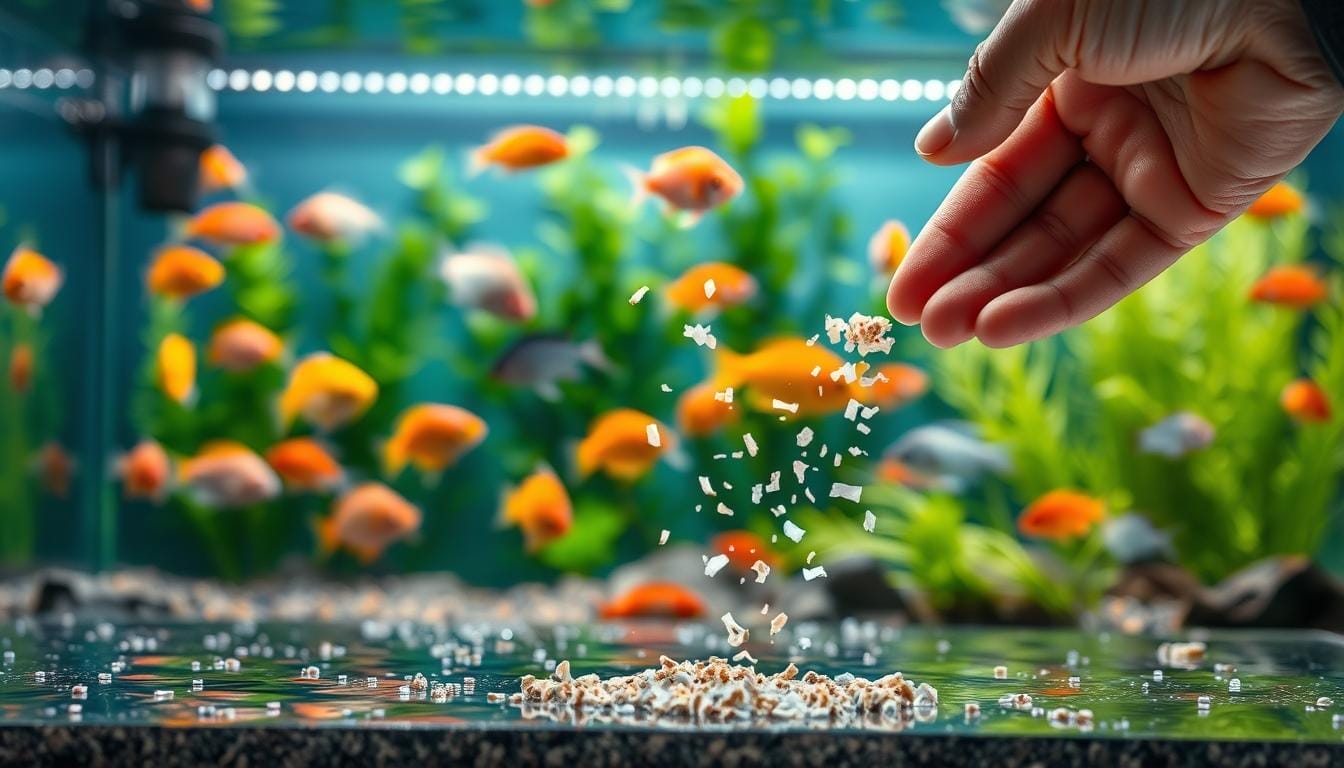
Your Guide to Choosing the Best Desktop Aquariums for Beginners
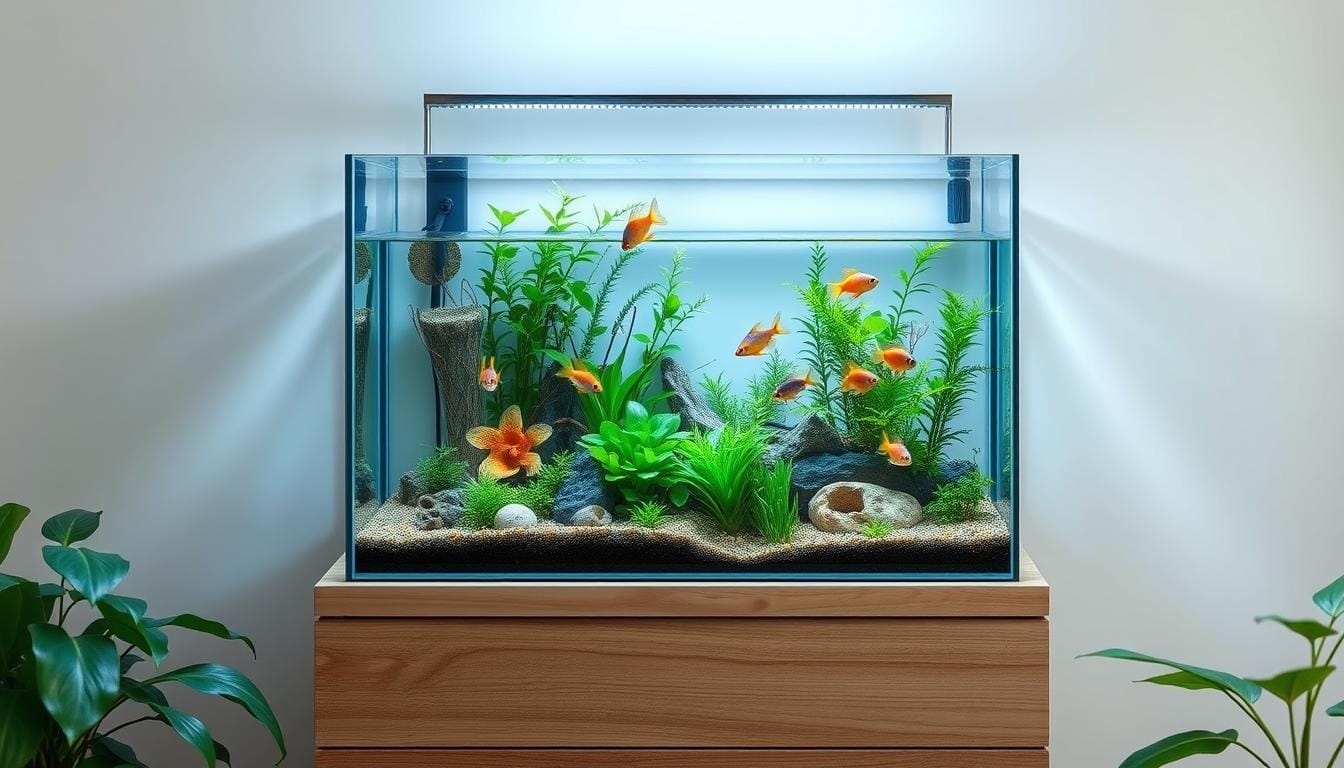
Studies show that observing aquatic life for just 10 minutes daily can reduce stress levels by up to 30%. Now imagine bringing that calming energy into your home or workspace with a self-contained ecosystem that fits right on your desk.
Compact tanks offer the perfect solution for first-time owners who want to enjoy fishkeeping without overwhelming maintenance. Whether you’re adding life to your office or creating a cozy corner at home, these setups blend practicality with natural beauty.
This guide simplifies your journey into aquatic hobbies. You’ll discover how to pick the right tank size, balance water chemistry, and choose between freshwater or marine species. We’ll help you avoid costly errors like overcrowding or improper filtration—common pitfalls new enthusiasts face.
By the end, you’ll know exactly how to create a thriving environment in limited space. Let’s turn your dream of owning a vibrant underwater world into reality—one thoughtful step at a time.
Understanding the World of Compact Aquariums
Small-space tanks revolutionize how we enjoy aquatic life. These clever designs pack everything your fish need into minimal square footage—ideal for tight spots like office desks or studio apartments. Most models hold 1-20 gallons, balancing visibility with practical upkeep.
Modern systems surprise with professional-grade features. Built-in filters keep water crystal clear, while LED lights mimic natural daylight cycles. You’ll find two main options: all-in-one units with hidden tech compartments, or customizable setups where you add components separately.
Why does tank size matter? Smaller volumes require precise care, but they’re simpler to manage daily. A 5-gallon system can comfortably house neon tetras or shrimp colonies when balanced correctly. You’ll master water testing and feeding routines faster than with larger habitats.
New hobbyists gain confidence through hands-on learning. Compact designs teach core skills without overwhelming you. They prove that thriving ecosystems don’t demand massive spaces—just smart planning and quality equipment.
Key Features to Consider in Desktop Aquariums
Your setup’s success starts with smart feature choices that balance beauty and functionality. Two elements make or break your experience: glass clarity and light performance. Let’s explore how these factors work together to create stunning underwater displays.
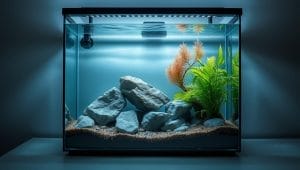
Design and Glass Quality
Premium materials transform how you interact with your tank. Ultra-clear glass—like the 8mm panels in RED SEA models—eliminates green tints for true-to-life colors. Thicker construction (4mm+) resists scratches and maintains structural integrity over time.
Rimless designs offer a clean, modern look while maximizing viewing angles. Unlike acrylic alternatives, quality glass stays crystal-clear with basic cleaning. You’ll spend less time polishing and more time enjoying vibrant aquatic scenes.
Lighting Options and Display Enhancements
LED systems do more than illuminate—they enhance life inside your tank. Adjustable spectrums highlight red plants or blue coral hues, creating depth in your display. Flexible mounts let you position lights for optimal coverage without glare.
Energy-efficient LEDs support photosynthesis while keeping costs low. Look for full-spectrum models that mimic natural daylight cycles. Proper lighting turns your setup into a living artwork that evolves throughout the day.
Essential Equipment and Accessories for Your Aquarium
Creating a thriving ecosystem starts with selecting components that work together seamlessly. The right tools handle waste removal, oxygen distribution, and nutrient balance while fitting your space constraints.
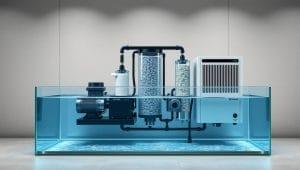
Filtration, Pumps, and Return Systems
Your filter acts as the system’s lungs. Multi-stage setups like RED SEA’s rear sump design combine mechanical sponges, biological media, and chemical treatments. This trio tackles debris, harmful bacteria, and dissolved toxins simultaneously.
A return pump determines water movement efficiency. The 950 GPH model circulates the entire tank volume 10 times hourly—ideal for sensitive species. Adjustable nozzles let you direct flow precisely where needed.
Saltwater enthusiasts should prioritize protein skimmers. These devices remove organic waste before decomposition, maintaining crystal-clear water. Pair them with specialized media like REEF-SPEC carbon for optimal results.
Complete kits simplify maintenance with pre-configured chambers. Look for bubble traps and micron filter bags that prevent clogs. Proper gph ratings ensure your pump matches both tank size and aquatic life needs.
Choosing the Right Tank Size and Dimensions for Your Space
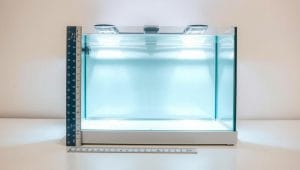
Measure your available area before selecting a tank. Consider both the base size and needed clearance—2-3 inches around all sides ensures easy maintenance. The PNW Custom Glass Small-In-One proves compact works: its 8x6x6-inch dimensions hold 1 gallon while fitting most desks.
Cube-shaped designs maximize water volume in tight spots. RED SEA’s 12-inch Cube model offers 5 gallons within a square footprint—ideal for limited-depth areas. Peninsula styles stretch horizontally, giving fish more swimming room without sacrificing desk real estate.
Weight matters more than you think. A filled 5-gallon tank weighs over 40 pounds—verify your surface supports it. Position where natural light won’t cause algae blooms but lets you enjoy the view during work breaks.
Match your space to aquatic needs. Shallow tanks suit air-breathing species, while taller dimensions help vertical swimmers. Whether you choose a 1-gallon micro-system or a 10-gallon showpiece, proper planning turns any corner into a thriving aquatic zone.
Exploring Product Innovations and Roundup Selections
Today’s compact aquatic systems blend smart engineering with user-friendly designs. Let’s examine standout options that simplify fishkeeping while delivering professional results.
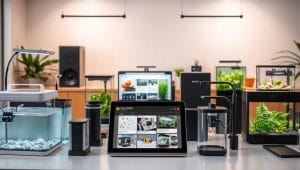
Highlights from Top-Tier Concepts
The RED SEA DESKTOP series redefines small-space possibilities. Its modular Peninsula and Cube formats let you build custom coral habitats with hidden equipment bays. You get marine-grade pumps and adjustable flow nozzles in a sleek package that fits any workspace.
For hassle-free setups, the PNW Glass Small-In-One shines. This 1-gallon marvel includes a water level indicator and evaporation cover—features usually found in premium systems. Its return pump operates whisper-quiet, perfect for offices or bedrooms.
What Real Users Say
Customer reviews praise both products’ intuitive assembly. One beginner shared: “I had fish swimming within an hour—no confusing parts.” Experts appreciate the flexibility to add advanced filtration while keeping setups compact.
Product comparisons reveal key differences. The RED SEA model suits those wanting expandable tech, while PNW’s all-inclusive kit eliminates guesswork. Both handle saltwater and freshwater, letting you switch environments as your skills grow.
These innovations prove you don’t need bulky equipment for stunning results. Whether starting simple or crafting intricate ecosystems, modern solutions adapt to your vision while simplifying daily care.
Desktop Aquariums: Features and Benefits for Beginners
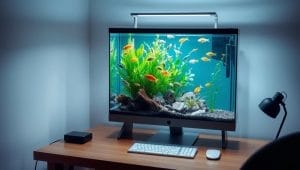
Starting your aquatic journey feels less intimidating with these scaled-down ecosystems. Their simplified design removes technical barriers, letting you focus on the joy of caring for your fish. You’ll appreciate how quickly these systems transform any corner into a living art piece—perfect for adding life to your home workstation or office nook.
Smaller water volumes work in your favor. Cycling completes faster than in traditional setups, meaning you can introduce fish within days rather than weeks. Weekly maintenance becomes a 10-minute task—swap a cup of water and wipe the glass. This hands-on approach helps you master feeding routines and spot health changes early.

Experiment freely without big investments. Try moss walls or colorful gravel knowing mistakes cost less to fix. The compact size makes testing water parameters effortless—no need for complex test kits. You’ll gain confidence to eventually upgrade while keeping your current tank as a thriving practice space.
These systems shine in tight living areas. Dorm rooms, studio apartments, and shared spaces gain personality without clutter. Your fish become low-maintenance companions that teach responsibility through daily interactions. It’s nature’s stress relief program, right on your desk.
Freshwater vs. Saltwater Options: What Suits Your Needs?
Choosing between freshwater and saltwater setups shapes your entire aquatic experience. Each path offers unique rewards and challenges, letting you create environments ranging from lush underwater gardens to vibrant coral displays. Modern systems like the RED SEA DESKTOP adapt to both worlds, giving you room to grow as your skills develop.
Understanding Environmental Requirements
Freshwater systems welcome newcomers with stable water conditions and forgiving parameters. Tropical fish like guppies or neon tetras thrive here, swimming among java ferns and anubias plants that naturally filter toxins. Colorful shrimp add movement to these miniature ecosystems, requiring only basic care routines.
Saltwater setups demand precise salinity levels but reward you with dazzling marine life. Clownfish dart through artificial anemones while hermit crabs scavenge live rock formations. For those ready to level up, soft corals like mushrooms or zoanthids bring mesmerizing textures. Always test water chemistry weekly if you choose this route—consistency prevents costly imbalances.
The RED SEA system’s flexible infrastructure lets you switch environments as your confidence grows. Start with a planted freshwater scene, then transition to corals using the same equipment. This adaptability reduces long-term costs while letting you explore different aquatic styles.
Consider your daily commitment before deciding. Freshwater needs 25% water changes monthly, while saltwater requires weekly testing and specialized additives. Both options deliver beauty—your choice depends on how hands-on you want to be with your underwater world.
Setting Up and Maintaining Your Compact Aquarium
Proper installation is key to a stress-free aquatic experience. Whether enhancing your home office or apartment nook, these tips ensure your ecosystem thrives while fitting seamlessly into daily life.
Smart Placement Strategies
Start by choosing a stable surface away from direct sunlight. Heat fluctuations stress aquatic life—keep your tank at least 3 feet from windows or radiators. The RED SEA DESKTOP’s 1.5-liter reservoir handles evaporation for 72 hours, perfect for busy schedules.
Consider these essentials during setup:
- Use the mounting arm for ReefLED 50 lights if skipping protein skimmers
- Opt for hanging kits when adding extra equipment like filters
- Ensure outlets support pumps, lights, and accessories simultaneously
Position your light 6-8 inches above water for optimal coverage. The adjustable arm lets you angle illumination without glare on screens—a home office must-have. Leave 2 inches clearance around all sides for easy glass cleaning and equipment checks.
Weekly maintenance stays simple. Test water weekly, wipe algae monthly, and let the automatic top-off handle evaporation. With smart planning, your compact habitat becomes a low-effort sanctuary that rewards you daily.
Maximizing Style and Display in Limited Spaces
Transform tight spaces into elegant showcases with design-forward aquatic displays. The RED SEA DESKTOP’s optional marine-spec cabinets blend seamlessly into your home or office, offering weatherproof protection while elevating your decor. Choose crisp white or sleek black exteriors to match existing furniture—these cabinet finishes maintain visual harmony in any room.
Why settle for basic setups when you can have functional art? The epoxy-coated doors resist moisture damage, keeping your space looking polished for years. Soft-close hinges operate silently—perfect for maintaining focus during work hours. Push-open mechanisms eliminate distracting hardware, creating clean lines that draw attention to your vibrant aquatic display.
- Match modern interiors with minimalist colors
- Enhance productivity through calming underwater views
- Maximize square footage with space-saving depth (under 12 inches)
Position your aquarium near workstations to create natural stress relief zones. Studies confirm that watching aquatic life lowers heart rates and boosts creativity. The compact footprint fits apartment nooks or crowded desks without sacrificing style.
Quality materials ensure your home upgrade stays timeless. Stainless steel components resist corrosion, while laminated surfaces wipe clean effortlessly. Whether placed in a sunlit living room or a cozy office corner, this system proves small-scale habitats can deliver big visual impact.
Integrating Aquatic Life: Fish, Corals, and Plants
Your mini underwater world thrives when every element works together. Start by selecting species that naturally complement each other’s needs. A well-planned environment reduces stress for inhabitants while simplifying your care routine.
Creating Balanced Ecosystems in a Mini Tank
Choose fish that prefer similar water conditions. Nano species like celestial pearl danios or chili rasboras add vibrant motion without overcrowding. Pair them with plants like java moss, which oxygenates water and provides hiding spots.
For saltwater setups, soft corals like zoanthids offer stunning color with minimal demands. Always research growth patterns—fast-growing species can overwhelm small spaces. A 5-gal system might host 2-3 small fish alongside cleanup crew shrimp.
Consider adding emergent plants above the waterline for visual depth. Pothos or peace lilies filter toxins while bridging aquatic and terrestrial aesthetics. This approach mimics natural ecosystems, creating stability through biodiversity.
Test water weekly and adjust feeding amounts based on your tank’s response. Over time, you’ll develop an intuitive understanding of your miniature habitat’s rhythms. Each choice brings you closer to a self-sustaining slice of nature.
FAQ
What’s the ideal tank size for a beginner’s setup?
A 5-10 gallon tank balances ease of maintenance and stability for freshwater species. Smaller volumes require more frequent water testing, while larger tanks offer better environmental control. Measure your space first—many compact models fit neatly on desks or shelves.
Do I need a filter and pump for a small aquarium?
Yes! Even nano tanks benefit from filtration. Look for systems with adjustable flow rates (100-200 GPH for 10-gallon tanks) to prevent stressing fish. Internal filters or all-in-one kits simplify setup and keep water clear of debris and excess protein.
Can I use regular LED lights for aquatic plants?
Standard LEDs often lack the full spectrum needed for photosynthesis. Choose fixtures labeled “full-spectrum” or “plant-grade” with 6500K color temperature. Brands like Fluval and NICREW offer slim designs that clip onto glass without crowding your workspace.
How often should I clean a compact freshwater tank?
Perform partial water changes (15-20%) weekly and vacuum substrate monthly. Test nitrate levels regularly—if they exceed 20 ppm, increase cleaning frequency. Avoid overfeeding, as uneaten food accelerates algae growth in small volumes.
Are saltwater nano tanks harder to maintain than freshwater?
Saltwater requires stricter parameter checks (salinity, calcium) and specialized equipment like protein skimmers. Beginners often succeed with hardy corals like zoanthids or softies in 10+ gallon setups. Start with freshwater to master basics before transitioning.
Can I add corals to a desktop-sized aquarium?
Yes, but stick to low-light varieties like mushrooms or star polyps in tanks under 15 gallons. Ensure your lighting supports their needs and maintain stable alkalinity (8-12 dKH). Pair with cleanup crews like snails to manage waste in tight ecosystems.
What’s the best way to secure a tank on an office desk?
Use non-slip mats beneath the aquarium and ensure the surface is level. Avoid placing near vents or windows—temperature swings stress aquatic life. For acrylic tanks, consider mounting arms or wall brackets to free up desk space.
How do I prevent algae in tanks with bright lighting?
Limit daily light exposure to 6-8 hours and introduce algae-eating species like nerite snails. Use phosphate-absorbing media in your filter and avoid overstocking. Dimmer-controlled LEDs let you adjust intensity without sacrificing display quality.





